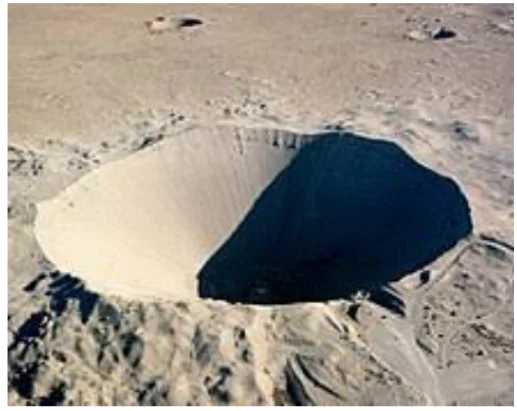Researchers from the Physical Research Laboratory (PRL) in Ahmedabad have found three new craters on Mars.
Three Craters Discovered on Mars
- Location of Craters: The craters are located in the Tharsis volcanic region, approximately at coordinates 21.0° S and 209° W.
IAU
- IAU is an international non- governmental organization that aims to advance astronomy globally.
- Establishment: 1919 in Brussels, Belgium.
- Headquarter: Paris, France.
- Objectives: It promotes research,education, and development through collaboration.
|
- IAU Approval: The International Astronomical Union (IAU) Working Group for Planetary System Nomenclature has approved the naming of these craters based on PRL’s recommendation.
Enroll now for UPSC Online Course
What is a Crater?

- A crater is a landform that features a hole or depression on a planetary surface.
- Causes: Typically formed by an object striking the surface or by geological activities such as meteorite, volcanic activity, or an explosion.
- Types of Craters
- Impact Crater: A depression formed by the high-speed impact of a smaller body on a planet, moon, or other solid object.
- Volcanic Crater: A bowl-shaped depression caused by volcanic activity, usually located above a volcano’s vent.
Mars
- Mars is the fourth planet from the Sun.
- Nickname: Known as “the Red Planet” due to its orange-red surface covered in iron(III) oxide dust.
- Planet Type: Classified as a terrestrial planet.
- Size: The second smallest planet in the Solar System, with a diameter of 6,779 km (4,212 mi).
- Natural Satellites
-
- Moons: Mars has two small, irregularly shaped moons named Phobos and Deimos.
|
-
- Explosion Crater: A crater formed by an explosion near or below the ground surface.
- Pit Crater: A depression formed by the collapse of the surface above a void or empty chamber.
- Subsidence Crater: A depression caused by the collapse of the roof of a cavity created by an underground explosion, usually nuclear.
Names of Newly Discovered Craters on Mars
- Lal Crater
- Named After: Prof. Devendra Lal, a distinguished Indian geophysicist and former director of PRL (1972-1983).
- Location and Size: A 65 km wide crater centered at -20.98° and 209.34°.
- Scientific Importance: The area of Lal crater, situated in the Tharsis volcanic region, is entirely covered with lava.
- Mursan Crater
- Named After: Mursan, a town in Uttar Pradesh, India.
- Location and Size: A ~10 km wide crater located on the eastern rim of the Lal crater.
- Hilsa Crater
- Named After: Hilsa, a town in Bihar, India.
- Location and Size: A ~10 km wide crater situated on the western rim of the Lal crater.
Check Out UPSC CSE Books From PW Store
![]() 13 Jun 2024
13 Jun 2024

